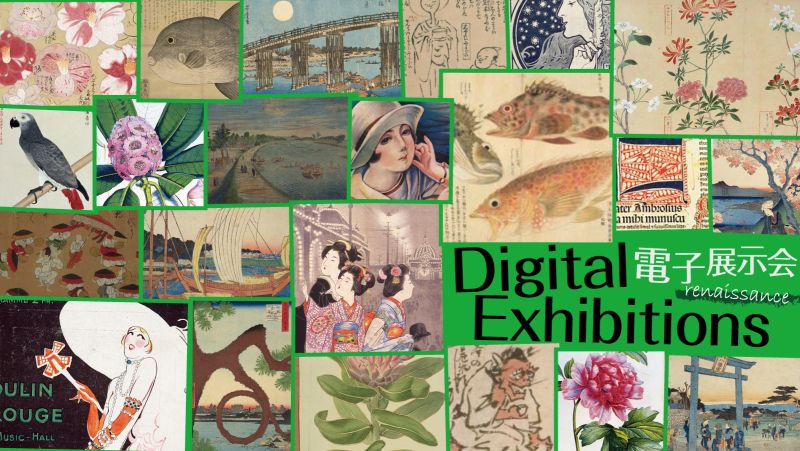The Tokyo nightscape as seen in the Kosenga of Inoue Yasuji’s Tokyo meisho

INOUE Yasuji published the first installment of his series Tokyo Meisho (Famous places in Tokyo) in 1881. INOUE had studied under ukiyo-e artist Kobayashi Kiyochika as a young man and created the Tokyo Meisho landscapes using Western printmaking techniques. INOUE died at the young age of twenty-six but the paintings he left behind form a vivid documentary that depicts the lives of ordinary people during the early Meiji era period. The works showcased here are nightscapes that depict a city in the midst of its transformation from old Edo to modern Tokyo under the influence of the bunmei-kaika (civilization and enlightenment) movement.
"Kaiunbashi Bridge" is a nightscape depicting the First National Bank of Japan as seen facing east across the Kaiunbashi Bridge in Tokyo's Nihonbashi. While the bank looms large in the background of this work, it is also depicted from other angles in works such as "Yoroibashi-yoru" (Night view of Yoroibashi Bridge), which views the bank looking west from the Nihonbashi River, and "Yoroibashi-no-kei" (View of Yoroibashi Bridge), which is not a nightscape per se but depicts the bank as seen from the opposite bank. The Western-style architecture of the First National Bank can be thought of as representative of the bunmei-kaika movement and in "Kaiunbashi Bridge" is depicted as an even darker shadow against a dark background as the people moving across the bridge in a town that still maintains its Edo-period characteristics.
The second work is a nightscape depicting the vicinity of the Kyoya clock tower in Ginza 4-chome. Light from gas street lamps and the inside of the buildings and vender stalls contrasts with the darkness of the horse-drawn railway carriage running along the tracks in the street. Willow trees can also be seen planted along the street. But featured most prominently of all is the Kyoya Clock Tower, a Western-style building built in Ginza around 1876, which was another symbol of the bunmei-kaika movement. The faintly illuminated silhouettes of the passengers riding the horse-drawn railway that runs past clock tower contribute to this vivid depiction of Ginza's nocturnal ambience.
The third nightscape featured here is of the Rokumeikan, which is inextricably associated with the bunmei-kaika movement and was the site of glamorous soirees at which meetings between Japanese and European diplomats took place. The Rokumeikan was built on the site of the Satsuma clan's Edo residence, which had been known as the Shozoku yashiki (costume mansion), because it was where envoys from the Ryukyu Kingdom donned their native costumes before entering Edo castle. Perhaps through this mysterious association, the Rokumeikan also became a place where people in Western costume gathered during the Meiji era. The light escaping the windows and the silhouettes of numerous people make it evident that some event is taking place. Upon closer viewing, there is a gentleman in the foreground, sitting on a bench in the garden. Perhaps he is feeling worn out from the party and needs some rest. His solitary figure sits in a stark contrast to the bustle of the socializing taking place inside the Western-style building.
The final work featured here is a nightscape of the Nihonbashi Bridge, as seen from Ichikokubashi Bridge. The Moon illuminates the surface of the river as people and horse-drawn railway carriages cross the bridge. The building seen on the far side of the bridge with all its lights on is a telegraph office.
This scene depicts the riverboats coming and going along the river, as they had since the Edo period, and the Western-style architecture of the telegraph office as a symbol of the bunmei-kaika movement coexisting in their natural states.
The nightscapes by INOUE Yasuji featured here are examples of kosenga (light ray pictures), a type of line drawing used in creating woodblock prints that attempts to depict shadows and light. INOUE did not subscribe to the blurring technique used by Kobayashi Kiyochika but instead attempted to depict light as delicately as possible. These line drawings bring out the shadows of the landscape, trees, and people to great effect, even in the darkness of a nightscape. In his line drawings, INOUE strives to preserve the natural appearance of the Tokyo cityscape.
